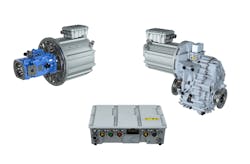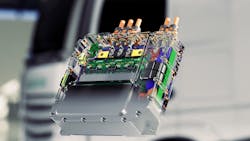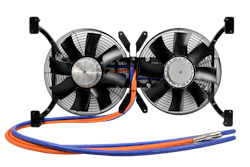As electrification increases, safety has become a critical factor which must be kept in mind. This is particularly true when working with the high-voltage systems being used in larger mobile applications such as heavy-duty trucks and off-highway equipment.
High-voltage systems—typically those operating around 400V—are utilized for many reasons. In addition to providing the power necessary for larger applications, higher voltages can help improve efficiency and charging times as well.
However, there are currently no safety standards in place for engineers to follow when developing and integrating high-voltage systems. According to Mike Terzo, CEO of Terzo Power Systems and member of Power & Motion’s Editorial Advisory Board, there is a lot of information for the automotive industry—which operates at lower voltages—but not as much for higher voltages and in particular for off-highway equipment applications. “There are some significant differences between automotive electrification and off-highway electrification,” he said during a Power & Motion education session on best practices for working with high-voltage systems.
Sign up for our Engineering Academy “Powering the Future of Electric Vehicles” to watch Mike Terzo’s session as well as others focused on technologies and techniques for developing electric vehicle systems.
Terzo also noted that much of the literature which does exist for automotive, and that slowly coming out for off-highway applications, is geared toward servicing electric vehicles. While important, there is also a need for safety information related to the design side.
Although standards do not yet exist, understanding high-voltage systems and some best practices for working with them can help to ensure safety.
Know Your System Architectures
When working with customers on their electric vehicle or equipment designs, Mourad Chergui, senior product manager at Delta-Q Technologies, said in an interview with Power & Motion that one of the first steps is determining what voltage level is needed for an application.
Doing so is important not only to ensure the appropriate power supply for an electric vehicle but also for component and safety system selection. Chergui said that while higher voltages can provide more performance and efficiency in many applications, there are also higher costs for the components and enhanced safety levels required which all should be taken into consideration as well.
For its eLION high-voltage electronic components, Bosch Rexroth chose 700V as the operating voltage due to the heavy equipment industry moving toward higher voltage ranges. Matthias Kielbassa, VP Electrification Off-Highway Mobile Machines at Bosch Rexroth, said during the company’s Electrified Mobile Product & Application Conference (EMPAC) at which the product line was introduced that the company saw the technological trends occurring in the commercial vehicle segment. While many applications started at 400V, there has already been a shift toward 700V and higher.
Thus, it was important to develop a product line which meets the industry trend of higher voltage ranges. He also explained that once above 100V, a system is considered high voltage. “That means all requirements with regards to electrical safety are exactly the same” no matter what voltage you use over 100V.
Understanding the system architecture—is it low or high voltage and is it an AC or DC system—that will be worked with is important to ensuring safety as well. Alternating current (AC) and direct current (DC) are the two methods used for current flow in electronics. Both are equally dangerous, and therefore safety precautions should always be taken when working with either, but there are some significant differences in their architectures which are important to keep in mind said Terzo.
AC systems are always grounded to earth he said. “When you touch something, basically you're touching a higher potential, and the ground is always a lower potential. So that is going to go through your body and induce current,” he explained. “Anywhere you are standing, you basically have one touch point to create a complete circuit in AC.”
When looking at DC systems, it is first important to note whether it is a low- or high-voltage system as Terzo said there is a distinction between the two. Low-voltage DC systems, usually 12 or 24V, have an architecture similar to that of an AC system in which the vehicle chassis is grounded. High-voltage DC systems, on the other hand, are completely isolated and so require two sources of contact. “And those two sources have to have a potential voltage difference to induce that current through you,” he said.
While 12 and 24V nominal systems are well understood at this point, Terzo said there is confusion for many engineers working with systems in higher voltage ranges as there is not quite an industry consensus on what is considered high voltage.
For industrial applications, the Occupational Safety and Health Administration (OSHA) in the U.S. has specified a threshold of 42.4V as the point at which it is not safe to touch any system components and use of protected and isolated connectors is required.
But on the vehicle side some in the industry say 48V is the threshold, leading to confusion for many. However, there is almost unanimous agreement that anything over 60V is the rate at which it is never safe to touch system components.
Terzo said his company works under the assumption that anything over 42V is high voltage and is treated as such when it comes to design and safety procedures. Doing so ensures consistent best practices are followed no matter what type of system is being worked on.
WATCH AND LEARN MORE: 3 Drivers of Off-Highway Electrification
Understand and Use Safety Features
High-voltage electric power systems have certain features included to ensure safety. One such feature is the high voltage interlock loop (HVIL), a wire which goes through all of the components in a high-voltage system.
If anything is disconnected from the system, it will break the HVIL signal which causes the vehicle’s electronic control unit (ECU) to shut off the mains contactor and disconnect the high voltage explained Terzo. By immediately notifying the system and disconnecting the high voltage, the HVIL helps to ensure any sources of danger are removed.
The pre-charge system is another important safety feature which Terzo said must be taken into consideration when working with high-voltage systems. “One of the reasons that I always bring [the pre-charge system] up is because it presents a significant safety issue on how we're designing systems and how we're implementing them into the field,” he said.
Essentially, the pre-charge system prevents a large inrush current from moving through the power system when it is turned on which could otherwise cause a lot of damage and a dangerous situation for those working with the system.
“So, what we do is implement a pre-charge circuit which allows us to control the amount of current going in through a pre-charge resistor; it slowly fills up the capacitor to get up to the voltage, then we can open our mains and we have a really safe completed circuit,” explained Terzo.
Another important element of the pre-charge system is the bleed off resister. This component helps to safely bleed off any voltage which may remain in the system even after it is disconnected. Due to the high levels of capacitance in high-voltage systems, Terzo said there can be a lot of voltage which remains after disconnection. As such, use of a bleed off resister as well as continuously monitoring system voltage is critical to ensuring safety when developing and working with high-voltage systems.
He also noted the importance of appropriately sizing the bleed off resister. In off-highway applications there is a desire to quickly bleed off any remaining voltage. However, if bled off too quickly, energy may be wasted which would not benefit performance of the final system and vehicle design. “There are a lot of design issues that go into ‘how do you start up and then bleed down the high voltage in your system,’” he said.
Apply Common Sense and Invest in the Right Tools
Terzo said his company follows automotive safety standards to an extent but has adapted some of those and learned more applicable best practices for high-voltage applications over the past 10 years of development work.
One of the key lessons his engineering team has learned is to break everything into smaller circuits and do incremental tests. This helps to ensure parts do not blow up or get damaged in other ways. Investing in the right equipment is important as well such as equipment to supply high voltage in a controlled manner. “The tools get exponentially more expensive, but they are exponentially more critical during the development path,” he said.
Use of safety interlocks and different connections to power supplies and power loads are among the protocols Terzo said his company followers. “We have redundant safety interlocks so if they ever get lifted up, they cause a trip which turns off the high-voltage power supply,” he explained. “And we try to isolate everything.”
When conducting testing, it is done in an enclosure to ensure there is minimal exposure. In addition, every part of the system is wired to sense what is happening in the different circuits to ensure performance and safety.
Overall, he said people should use common sense when working with high-voltage systems. They should treat everything they work with as a dangerous, high-voltage component and wear appropriate safety gear like glasses.
Practice Open Collaboration
Chergui agreed with Terzo there is a lack of standards for high-voltage systems and their use in off-road equipment. He said Delta-Q and its parent company Zapi Group—which supplies powertrain components for electric vehicles—are working to establish their own guidelines to aid development efforts with OEM customers.
“We already have some experience with 400V, but [are also moving] to 800V,” said Chergui. “We are collaborating with various OEMs to actually understand what their needs are.”
He also noted that companies supplying high-voltage components are limited compared to those offering low-voltage versions. Because of this, he said more openness and communication between OEMs and suppliers will be important to expanding not only availability of high-voltage systems but also development of safety processes.
Terzo said it is important for the industry to share information since electrification is still so new for many. There are companies who are not as willing to discuss what they are working on but he believes it is important to do so in order to help the industry progress.
Fernando Pulido, Product Manager (On-Highway) at Horton Inc.—which is currently developing a high-voltage cooling system—said in an interview with Power & Motion the move to electrification and high-voltage systems is a new endeavor for many OEMs and their suppliers. As such, everyone is learning and working together to best determine how to proceed in this space.
He said it is important for Horton and other manufacturers to be a participant in this transition. “The more you participate and help shape the specifications and requirements moving down the road, the better your chances to reserve a seat at the table.”
Pulido said having a high level of cooperation with OEM customers and sub-suppliers is beneficial. Honesty is important as well. Issues may arise or things done in the past may no longer be necessary so it will be vital to challenge previous norms and have honest conversations during the development process.
Both Chergui and Terzo believe there is a need for industry standards to be developed beyond those available for automotive. Associations, safety agencies, government, and members of the industry itself should all step in and begin the work to establish guidelines manufacturers can follow. Chergui said he believes such standards will come in time.
“Standards always lag the industry,” said Terzo. “I think it is important we try to change that because standardization should come earlier in the process. That would accelerate everything and provide a much safer environment.”
When standards are eventually developed, Terzo said the industry could piggyback off of some of the automotive industry’s best practices. This would include use of common colors, logos, and labels to signify any dangerous parts.
Standardization of voltage classifications is one of the first aspects which he said needs to take place. There is still debate among many as to what is considered low or high voltage. But if the industry can come to a consensus, then it can be better equipped to handle future development efforts and the creation of safety procedures.
Additional Safety Information
While safety information for working with high-voltage systems is more limited than that for low-voltage and automotive applications, Mike Terzo, CEO of Terzo Power Systems, provided the following as good resources for design teams.
- Battery Safety Initiatives for Electric Vehicles from the National Highway Traffic Administration (NHTSA)
- Fundamentals of High Voltage xEV, Safety, and PPE from SAE International
- High Voltage Training for Future Mobility from DEKRA
- High Voltage Vehicle Safety from SAE International
About the Author
Sara Jensen
Executive Editor, Power & Motion
Sara Jensen is executive editor of Power & Motion, directing expanded coverage into the modern fluid power space, as well as mechatronic and smart technologies. She has over 15 years of publishing experience. Prior to Power & Motion she spent 11 years with a trade publication for engineers of heavy-duty equipment, the last 3 of which were as the editor and brand lead. Over the course of her time in the B2B industry, Sara has gained an extensive knowledge of various heavy-duty equipment industries — including construction, agriculture, mining and on-road trucks —along with the systems and market trends which impact them such as fluid power and electronic motion control technologies.
You can follow Sara and Power & Motion via the following social media handles:
X (formerly Twitter): @TechnlgyEditor and @PowerMotionTech
LinkedIn: @SaraJensen and @Power&Motion
Facebook: @PowerMotionTech

Leaders relevant to this article:





